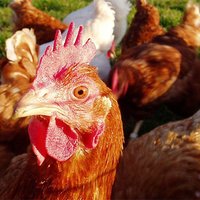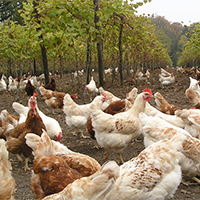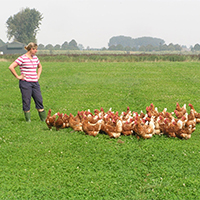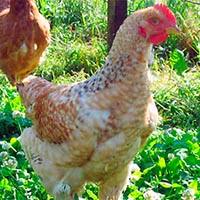HealthyHens ready with advices for organic egg producers
The results of the project HealthyHens have been summarised into recommendations within four essential areas: Prevention of intestinal worms, of feather and injurious pecking, of foot problems and keel bone deviations and, finally, optimisation of the use of outdoor areas.

In organic egg production hens should have access to outdoor areas, producers aim to achieve 100 % organic feeding, and beak trimming is not used. These factors imply a series of challenges to the producers.
HealthyHens focuses on the major bottlenecks of organic production systems in relation to hen health, which are prevention of parasite impact, feather pecking, feet and breastbone problems as well as an optimum use of outdoor areas.
Among other findings, the project demonstrated that maximising the accessibility of the outdoor range had multiple positive effects: Intestinal worms were not a major problem in flocks with free access to outdoor areas for most of the time, compared to flocks with limited access to outdoor areas. Additionally, the risks of feather damage and pecking wounds were reduced in flocks with long access times to the outdoor range.
Joint epidemiological study
Various reasons exist for parasite infection and serious health and welfare problems such as feather pecking, cannibalism and foot lesions and some of the contributing factors may be housing and management. In many individual European countries the number of organic hen flocks and the variation in husbandry conditions is too small to be able to accomplish a sufficiently significant epidemiological study to identify risk factors in relation to these health problems.
Thus, in the HealthyHens project eight countries cooperated in a joint epidemiological study with a uniform registration protocol. This means that we were able to accomplish an epidemiological study based on 110 flocks distributed in 8 countries. Each flock was visited twice: At peak of lay (when hens were 30-40 weeks old) and when hens were 60-65 weeks old. Information on housing and management were recorded during interviews with the organic egg producers as well as by means of farm registrations. Animal-based indicators were recorded by inspection of a random sample of hens. Data collection took place between February 2012 and March 2014.



Parasite infection
Fifteen hens from 55 different flocks were examined for intestine presence of roundworms (Ascaridia galli), Heterakis worms (Heterakis spp.) and tapeworms (Railletina spp.) after killing or slaughter. Roundworm infection was prevalent in all countries and almost all flocks. The prevalence of hens with roundworm infections ranged from 0 to 100 % with a mean of 68 %. For Heterakis worms, the mean prevalence was 32 %, also with a range from 0 to 100 %. The prevalence of hens with tapeworms was found to be between 0 % and 73 % with a mean of 13 %.
Positive effects of outdoor range
The average number of roundworms found in the hens showed large variation between flocks; ranging from 0 to 56 roundworms per hen with a mean of 10 worms. As regards Heterakis infections the average number per flock varied from 0 to 121 worms per hen with a mean of 17 worms. Access to outdoor areas had a significant effect on the number of roundworms. The more hours per day the hens had access to the outdoors, the lower the mean worm burden. Coarse fodder allocation did not affect the prevalence of intestinal worms.
An examination of droppings demonstrated that eggs from roundworms (Ascaridia galli) and Heterakis worms combined had a prevalence of 55 % at peak of lay and 61 % when visited at the age of 60-65 weeks in the eight countries. Compared to this the prevalence of roundworms was 68 % and of Heterakis worms 28 % in killed hens across the countries. The egg counts were probably mainly based on Ascaridia eggs, as intestinal droppings were used for analysis and Heterakis eggs are found in ceacal droppings to a larger extent.
Cardboard mite traps were used to examine blood mite levels. The number of blood mites – from at least 5 traps randomly distributed at the farm – varied between 0 and more than 10,000 irrespective of the traps being used in summer or winter.
High variation between farms
Plumage and keel bone evaluations were accomplished in 50 hens per flock at the age of 60-65 weeks. The results demonstrated that 0 to 100 % of the sampled hens had poor plumage and 0 to 96 % had wounds. Keel bone examinations revealed deviations or fractures present in at least one hen in every flock. Callus material as a result of former fractures was palpable in 0 to 88 % of hens per flock (mean 28 %) and deviations in 0 to 84 % of hens per flock (mean 31 %). Generally, the variation between the individual farms in the countries was high.
Recommendations for egg producers
Many organic egg producers from most of Europe were directly involved in the project and have been directly affected by it; partly by contributing to the data collecting and partly by being informed about the results achieved. The results have been summarised in the form of recommendations in relation to the prevention of intestinal worms, optimisation of the use of outdoor areas, and the prevention of feather pecking and poultry diseases.
The recommendations are now available on the project’s website and here.
These recommendations are expected to constitute an important information source for organic egg producers in the future. The joint European data set collected during the project will be relevant for future decisions regarding the development of organic egg production.
HealthyHens is funded by CORE Organic II funding bodies. It ended 31 December 2014.
Read more
Go to "Recommendations to ensure hen health and welfare in organic husbandry" (English)
The leaflet is also available in German, Italian, Dutch, Swedish and Danish
Read about the project on Organic Eprints
Contact persons:
Christine Brenninkmeyer and Ute Knierim,
University of Kassel, Germany
E-mail: brenninkmeyer@wiz.uni-kassel.de and knierim@wiz.uni-kassel.de